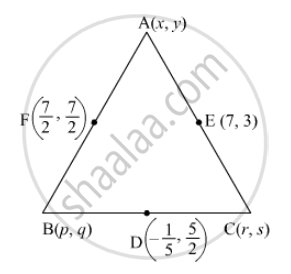Advertisements
Advertisements
Question
If \[D\left( - \frac{1}{5}, \frac{5}{2} \right), E(7, 3) \text{ and } F\left( \frac{7}{2}, \frac{7}{2} \right)\] are the mid-points of sides of \[∆ ABC\] , find the area of \[∆ ABC\] .
Solution

The midpoint of BC is \[D\left( - \frac{1}{5}, \frac{5}{2} \right)\],
The midpoint of AB is \[F\left( \frac{7}{2}, \frac{7}{2} \right)\] ,
The midpoint of AC is \[E\left( 7, 3 \right)\] Consider the line segment BC,
\[ \Rightarrow p + r = - 1 ; q + s = 5 . . . . . (i)\]
\[\text{ Consider the line segment AB, } \]
\[ \Rightarrow \frac{p + x}{2} = \frac{7}{2} ; \frac{q + y}{2} = \frac{7}{2}\]
\[ \Rightarrow p + x = 7 ; q + y = 7 . . . . . (ii)\]
\[\text{ Consider the line segment AC, } \]
\[ \Rightarrow \frac{r + x}{2} = 7 ; \frac{s + y}{2} = 3\]
\[ \Rightarrow r + x = 14 ; s + y = 6 . . . . . (iii)\]
Solve (i), (ii) and (iii) to get
\[BC = \sqrt{\left( - 4 - 3 \right)^2 + \left( 3 - 2 \right)^2} = \sqrt{50}\]
\[\text{ Equation of the line BC is } \]
\[\frac{x + 4}{- 4 - 3} = \frac{y - 3}{3 - 2}\]
\[ \Rightarrow x + 7y - 17 = 0\]
\[\text{ The perpendicular distance from a point } P\left( x_1 , y_1 \right)is\]
\[P = \left| \frac{1\left( 11 \right) + 7\left( 4 \right) - 17}{\sqrt{50}} \right| = \frac{22}{\sqrt{50}}\]
The area of the triangle is \[A = \frac{1}{2} \times \sqrt{50} \times \frac{22}{\sqrt{50}} = 11 \text{ sq . units } \]
APPEARS IN
RELATED QUESTIONS
Prove that the points (3, -2), (4, 0), (6, -3) and (5, -5) are the vertices of a parallelogram.
Three consecutive vertices of a parallelogram are (-2,-1), (1, 0) and (4, 3). Find the fourth vertex.
The points A(2, 0), B(9, 1) C(11, 6) and D(4, 4) are the vertices of a quadrilateral ABCD. Determine whether ABCD is a rhombus or not.
Show that the points A (1, 0), B (5, 3), C (2, 7) and D (−2, 4) are the vertices of a parallelogram.
If the poin A(0,2) is equidistant form the points B (3, p) and C (p ,5) find the value of p. Also, find the length of AB.
In what ratio is the line segment joining A(2, -3) and B(5, 6) divide by the x-axis? Also, find the coordinates of the pint of division.
Show that the points (−2, 3), (8, 3) and (6, 7) are the vertices of a right triangle ?
The ordinate of any point on x-axis is
The perpendicular distance of the P (4,3) from y-axis is
Find the ratio in which the line segment joining the points A(3, −3) and B(−2, 7) is divided by the x-axis. Also, find the coordinates of the point of division.
If the points A(1, –2), B(2, 3) C(a, 2) and D(– 4, –3) form a parallelogram, find the value of a and height of the parallelogram taking AB as base.
What is the distance between the points (5 sin 60°, 0) and (0, 5 sin 30°)?
If the area of the triangle formed by the points (x, 2x), (−2, 6) and (3, 1) is 5 square units , then x =
If points A (5, p) B (1, 5), C (2, 1) and D (6, 2) form a square ABCD, then p =
The coordinates of the fourth vertex of the rectangle formed by the points (0, 0), (2, 0), (0, 3) are
What is the nature of the line which includes the points (-5, 5), (6, 5), (-3, 5), (0, 5)?
Find the coordinates of the point of intersection of the graph of the equation x = 2 and y = – 3
What are the coordinates of origin?
The perpendicular distance of the point P(3, 4) from the y-axis is ______.
In which ratio the y-axis divides the line segment joining the points (5, – 6) and (–1, – 4)?
